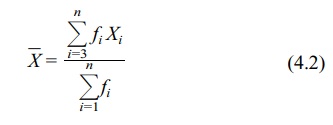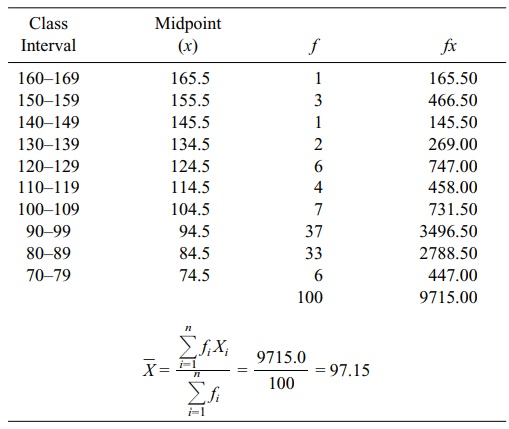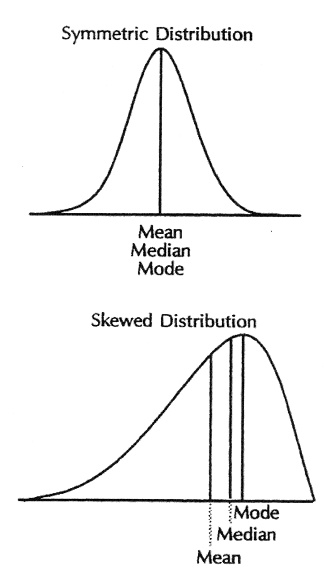Measures of Central Tendency
| Home | | Advanced Mathematics |Chapter: Biostatistics for the Health Sciences: Summary Statistics
Measures of central tendency are numbers that tell us where the majority of values in the distribution are located.
Summary Statistics
MEASURES OF CENTRAL TENDENCY
The previous chapter, which discussed data displays
such as frequency histograms and frequency polygons, introduced the concept of
the shape of distributions of data. For example, a frequency polygon
illustrated the distribution of body mass in-dex data. Chapter 4 will expand on
these concepts by defining measures of central tendency and measures of
dispersion.
Measures of central tendency are numbers that tell
us where the majority of values in the distribution are located. Also, we may
consider these measures to be the center of the probability distribution from
which the data were sampled. An example is the average age in a distribution of
patients’ ages. Section 4.1 will cover the following measures of central
tendency: arithmetic mean, median, mode, geometric mean, and harmonic mean.
These measures also are called measures of location. In contrast to measures of
central tendency, measures of dispersion inform us about the spread of values
in a distribution. Section 4.2 will present measures of dispersion
1. The Arithmetic Mean
The arithmetic mean is the sum of the individual
values in a data set divided by the number of values in the data set. We can
compute a mean of both a finite population and a sample. For the mean of a
finite population (denoted by the symbol μ), we sum the individual observations in the entire population and
divide by the popula-tion size, N.
When data are based on a sample, to calculate the sample mean (denoted by the
symbol (![]() )
we sum the individual observations in the sample and divide by the number of
elements in the sample, n. The sample
mean is the sample analog to the mean of a finite population. Formulas for the
population (4.1a) and sample means (4.1b) are shown below; also see Table 4.1.
)
we sum the individual observations in the sample and divide by the number of
elements in the sample, n. The sample
mean is the sample analog to the mean of a finite population. Formulas for the
population (4.1a) and sample means (4.1b) are shown below; also see Table 4.1.
TABLE 4.1. Calculation of Mean (Small Population, N = 5)

where Xi
are the individual values from a finite population of size N.

where Xi
are the individual values of a sample of size n.
The population mean (and also the population
variance and standard deviation) is a parameter of a distribution. Means,
variances, and standard deviations of finite populations are almost identical
to their sample analogs. You will learn more about these terms and appreciate
their meaning for infinite populations after we cover absolutely continuous
distributions and random variables in Chapter 5. We will refer to the
individual values in the data set as elements, a point that will be discussed
in more detail in Chapter 5, which covers probability theory.
Statisticians generally use the arithmetic mean as
a measure of central tendency for numbers that are from a ratio scale (e.g.,
many biological values, height, blood sugar, cholesterol), from an interval
scale (e.g., Fahrenheit temperature or personal-ity measures such as
depression), or from an ordinal scale (high, medium, low). The values may be
either discrete or continuous; for example, ranking on an attitude scale
(discrete values) or blood cholesterol measurements (continuous).
It is important to distinguish between a continuous
scale such as blood cholesterol and cholesterol measurements. While the scale
is continuous, the measurements we record are discrete values. For example,
when we record a cholesterol measurement of 200, we have converted a continuous
variable into a discrete measurement. The speed of an automobile is also a
continuous variable. As soon as we state a specific speed, for example, 60
miles or 100 kilometers per hour, we have created a discrete measurement. This
example becomes clearer if we have a speedometer that gives a digital readout
such as 60 miles per hour.
For large data sets (e.g., more than about 20
observations when performing calculations by hand), summing the individual
numbers may be impractical, so we use grouped data. When using a computer, the
number of values is not an issue at all. The procedure for calculating a mean
is somewhat more involved for grouped data than for ungrouped data. First, the
data need to be placed in a frequency table, as illustrated in Chapter 3. We
then apply Formula 4.2, which specifies that the midpoint of each class
interval (X) is multiplied by the
frequency of observation in that class.
The mean using grouped data is

where Xi
is the midpoint of the ith interval
and fi is the frequency of
observations in the ith interval.
In order to perform the calculation specified by
Formula 4.2, first we need to place the data from Table 4.2 in a frequency
table, as shown in Table 4.3. For a re-view of how to construct such a table,
consult Chapter 3. From Table 4.3, we can see that ΣfX = 9715, Σf = n = 100, and that the mean is estimated as 97.2 (rounding to the nearest
tenth).
2. The Median
Previously in Chapter 3, we defined the term median
and illustrated its calculation for small data sets. In review, the median
refers to the 50% point in a frequency dis
TABLE 4.2. Plasma Glucose Values (mg/dl) for a Sample of 100 Adults,
Aged 20–74 Years

TABLE 4.3. Calculation of a Mean from a Frequency Table (Using Data from
Table 4.2)

When data are grouped in
a frequency table, the median is an estimate because we are unable to calculate
it precisely. Thus, Formula 4.3 is used to estimate the median from data in a
frequency table:
median = lower limit of the interval + i(0.50n – cf) (4.3)
where i =
the width of the interval
n = sample size (or N = population size)
cf = the cumulative frequency below the interval that
contains the median
The sample median (an analog to the population
median) is defined in the same way as a population median. For a sample, 50% of
the observations fall below and 50% fall above the median. For a population,
50% of the probability distribution is above and 50% is below the median.
In Table 4.4, the lower end of the distribution
begins with the class 70–79. The column “cf”
refers to the cumulative frequency of cases at and below a particular interval.
For example, the cf at interval 80–89
is 39. The cf is found by adding the
numbers in columns f and cf diagonally; e.g., 6 + 33 = 39. First,
we must find the interval in which the median is located. There are a total of
100 cases, so one-half of them (0.50n)
equals 50. By inspecting the cumulative frequency column, we find the interval
in which 50% of the cases (the 50th case) fall in or below: 90–99. The lower
real limit of the interval is 89.5.
Here is a point that requires discussion.
Previously, we stated that the mea
TABLE 4.4. Determining a Median from a Frequency Table

The numbers placed in the frequency table were continuous
numbers rounded off to the nearest unit. The real limits of the class interval
are halfway between adjacent intervals. As a result, the real limits of a class
interval, e.g., 90–99, are 89.5 to 99.5. The width of the interval (i) is (99.5
– 89.5), or 10. Thus, placing these values in Formula 4.3 yields
median = 89.5 + 10[(0.50)(100) – 39] = 97.47
For data that have not been grouped, the sample
median also can be calculated in a reasonable amount of time on a computer. The
computer orders the observations from smallest to largest and finds the middle
value for the median if the sample size is odd. For an even number of
observations, the sample does not have a middle value; by convention, the
sample median is defined as the average of two values that fall in the middle
of a distribution. The first number in the average is the largest ob-servation
below the halfway point and the second is the smallest observation above the
halfway point.
Let us illustrate this definition of the median
with small data sets. Although the definition applies equally to a finite
population, assume we have selected a small sample. For n = 7, the data are {2.2, 1.7, 4.5, 6.2, 1.8, 5.5, 3.3}. Ordering
the data from smallest to largest, we obtain {1.7, 1.8, 2.2, 3.3, 4.5, 5.5,
6.2}. The middle observation (median) is the fourth number in the sequence;
three values fall below 3.3 and three values fall above 3.3. In this case, the
median is 3.3.
Suppose n
= 8 (the previous data set plus one more observation, 5.7). The new data set
becomes {1.7, 1.8, 2.2, 3.3, 4.5, 5.5, 5.7, 6.2}. When n is even, we take the average of the two middle numbers in the
data set, e.g., 3.3 and 4.5. In our example, the sample median is (3.3 + 4.5)/2
= 3.9. Note that there are three observations above and three below the two
middle observations.
3. The Mode
The mode refers to the class (or midpoint of the
class) that contains the highest fre-quency of cases. In Table 4.4, the modal
class is 90–99. When a distribution is por-trayed graphically, the mode is the
peak in the graph. Many distributions are multi-modal, referring to the fact
that they may have two or more peaks. Such multimodal distributions are of
interest to epidemiologists because they may indicate different causal
mechanisms for biological phenomena, for example, bimodal distributions in the
age of onset of diseases such as tuberculosis, Hodgkins disease, and
meningo-coccal disease. Figure 4.1 illustrates unimodal and bimodal
distributions.
4. The Geometric Mean
The geometric mean (GM) is found by multiplying a
set of values and then finding their nth
root. All of the values must be non-0 and greater than 1. Formula 4.4 shows how
to calculate a GM.

A GM is preferred to an arithmetic mean when
several values in a data set are much higher than all of the others. These
higher values would tend to inflate or dis-tort an arithmetic mean. For
example, suppose we have the following numbers: 10, 15, 5, 8, 17. The
arithmetic mean is 11. Now suppose we add one more number- 100—to the previous
five numbers. Then the arithmetic mean is 25.8, an inflated value not very
close to 11. However, the geometric mean is 14.7, a value that is closer to 11.
In practice, is it desirable to use a geometric
mean? When greatly differing val-ues within a data set occur, as in some biomedical
applications, the geometric mean becomes appropriate. To illustrate, a common
use for the geometric mean is to de-termine whether fecal coliform levels
exceed a safe standard. (Fecal coliform bacte-ria are used as an indicator of
water pollution and unsafe swimming conditions at

Figure 4.1. Unimodal and bimodal distribution
curves. (Source: Authors.)
beaches.) For example, the standard may be set at a
30-day geometric mean of 200 fecal coliform units per 100 ml of water. When the
water actually is tested, most of the individual tests may fall below 200
units. However, on a few days some of the values could be as high as 10,000
units. Consequently, the arithmetic mean would be distorted by these extreme
values. By using the geometric mean, one obtains an average that is closer to
the average of the lower values. To cite another example, when the sample data
do not conform to a normal distribution, the geometric mean is especially
useful. A log transformation of the data will produce a symmetric dis-tribution
that is normally distributed.
Review Formula 4.4 and note the nth root of the product of a set of
numbers. You may wonder how to find the nth
root of a number. This problem is solved by logarithms or, much more easily, by
using the “geometric mean function” in a spreadsheet program.
Here is a simple calculation example of the GM. Let
X1, X2, X3,
. . . , Xn denote our
sample of n values. The geometric
mean is the nth root of the product
of these values, or (X1 X2 X3 . . . Xn)1/n .
If we apply the log transformation to this
geometric mean we obtain {log(X1)
+ log(X2) + log(X3) + . . . + log(Xn)}/n. From these calculations, we see that the GM is the arithmetic
mean of the data after transforming them to a log scale. On the log scale, the
data become symmetric. Consequently, the arithmetic mean is the natural
parameter to use for the location of the distribution, confirming our suspicion
that the geometric mean is the correct measure of central tendency on the
original scale.
5. The Harmonic Mean
The harmonic mean (HM) is the final measure of
location covered in this chapter. Although the HM is not used commonly, we
mention it here because you may en-counter it in the biomedical literature.
Refer to Iman (1983) for more information about the HM, including applications
and relationships with other measures of loca-tion, as well as additional
references.
The HM is the reciprocal of the arithmetic average
of the reciprocals of the orig-inal observations. Mathematically, we define the
HM as follows: Let the original observations be denoted by X1, X2,
X3, . . . , Xn. Consider the observations
Y1, Y2, Y3,
. . . , Yn obtained by
reciprocal transformation, namely Yi
= 1/Xi for i = 1, 2, 3, . . . , n. Let Yh denote the arithmetic average of the Y’s, where

The harmonic mean (HM) of the X’s is 1/Yh:

where Yi
= 1/Xi for i = 1, 2, 3, . . . , n and Yh = (ΣYi)/n.
6. Which Measure Should You Use?
Each of the measures of central tendency has
strengths and weaknesses. The mode is difficult to use when a distribution has
more than one mode, especially when these modes have the same frequencies. In
addition, the mode is influenced by the choice of the number and size of
intervals used to make a frequency distribution.
The median is useful in describing a distribution
that has extreme values at either end; common examples occur in distributions
of income and selling prices of houses. Because a few extreme values at the
upper end will inflate the mean, the median will give a better picture of
central tendency.
Finally, the mean often is more useful for
statistical inference than either the mode or the median. For example, we will
see that the mean is useful in calculating an important measure of variability:
variance. The mean is also the value that mini-mizes the sum of squared
deviations (mean squared error) between the mean and the values in the data
set, a point that will be discussed in later chapters (e.g., Chapter 12) and
that is exceedingly valuable for statistical inference.
The choice of a particular measure of central
tendency depends on the shape of the population distribution. When we are
dealing with sample-based data, the distri-bution of the data from the sample
may suggest the shape of the population distrib-ution. For normally distributed
data, mathematical theory of the normal distribution (to be discussed in
Chapter 6) suggests that the arithmetic mean is the most appro-priate measure
of central tendency. Finally, as we have discussed previously, if a log
transformation creates normally distributed data, then the geometric mean is
ap-propriate to the raw data.
How are the mean, median, and mode interrelated? For symmetric distributions, the mean and median are equal. If the distribution is symmetric and has only one mode, all three measures are the same, an example being the normal distribution. For skewed distributions, with a single mode, the three measures differ. (Refer to Figure 4.2.) For positively skewed distributions (where the upper, or left, tail of the distribution is longer (“fatter”) than the lower, or right, tail) the measures are ordered as follows: mode < median < mean. For negatively skewed distributions (where the lower tail of the distribution is longer than the upper tail), the reverse or-dering occurs: mean < median < mode.

Figure 4.2. Mean, median, and mode, symmetric and skewed distributions. (Source: Centers for Dis-ease Control and Prevention (1992). Principles of Epidemiology, 2nd Edition, Figure 3.11.)

Figure 4.3. Symmetric (B) and skewed distributions: right skewed (A) and left skewed (C). (Source: Centers for Disease Control and Prevention (1992). Principles of Epidemiology, 2nd Edition, Figure 3.5)
Figure 4.3 shows symmetric and skewed distributions. The fact that
the median is closer to the mean than is the mode led Karl Pearson to observe
that for moderately skewed distributions such as the gamma distribution, mode
– mean ≈ 3(median – mean). See Stuart and Ord (1994) and Kotz and Johnson (1985)
for more details on these relationships.
Related Topics
